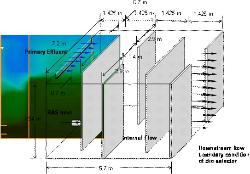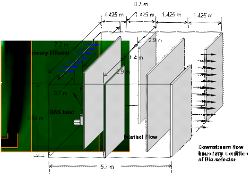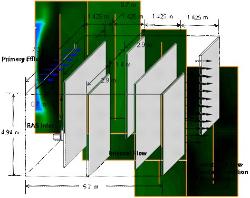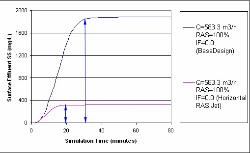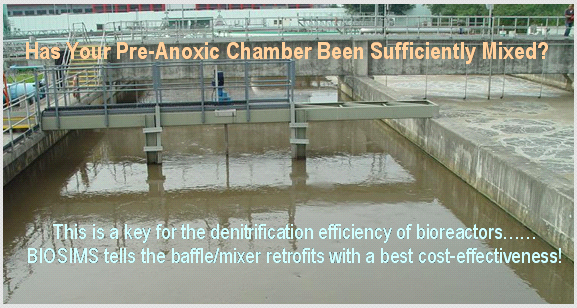
Click image for large view
Fig. 1 Poor mixing in a bio-selector with a
horizontal RAS return inlet (Side view)
horizontal RAS return inlet (Side view)
In addition to the traditional kinetic process modeling, the ReactorSIMs modeling technology could allow
design engineers and project owners to look at their process efficiency from a brand new aspect.
The efficiency of bioreactors could be limited by a poor mixing
One of the most important factors that determines the efficiency of a bioreactor is its mixing. The
bioreactor could consist of several different chambers in different processes as:
- Bio-selector
- Anoxic zone
- Aerobic zone
- Anaerobic zone
In any processes, the mixing occurs between two or more components below to form the MLSS in
different chambers. They are:
- Primary effluent,
- RAS return
- Internal flow recycling
- Air flux
- Incoming MLSS from an upstream chamber
The traditional bioreactor design assumes plug flow and complete-mixing within the entire bioreactor. It
is easier to obtain an idealized flow and solids mixing in a pilot testing unit, which is a common tool to
gather basic design data for a process design, because of its very small volume. However, in many field
investigations for prototype processes, the significant differences among MLSS sampled at different
locations indicate that prototype bioreactors may not very often achieve the idealized plug flow and
complete-mixing. This could be one of the major explanations for a pilot testing unit normally to have a
better performance than that of the prototype completed later on. The design of the prototype bioreactor
is much more exacting than for a pilot unit if both of them aim to achieve similar performance. The
mixing and local flow regime problem in prototype bioreactors has caught the attention of more and
more design engineers in recent years.
An optimized design or minor retrofit could significantly enhance the Mixing in a bioreactor
Figures 1 to 4 present the Biosims predicted solids fields in a bio-selector, which is a front end
chamber in a bioreactor under the process condition having the primary effluent flow of 14,000 m3/day,
RAS flow of 100% and zero internal flow. Comparing the solids fields and related flow regime between
the two alternatives, it can be concluded that the mixing efficiency of this bio-selector is greatly
dependent on the selection of design alternatives. For the same loading condition and identical tank
configuration, the Mixing Efficiency dramatically increases from 0.42 to 0.91 because a sludge inlet
elbow is applied to change the RAS entering direction. In this case the initial momentum of RAS influent
is directed towards the surface by using the elbow at the end of the RAS influent pipe (see Figures 3
and 4). The design alternative is able to move up the heavier RAS flow to surface layers in most of the
process operations having a RAS influent velocity (V) higher than 0.4 m/sec.
An optimized design or minor retrofit could significantly increase Actual Sludge Contact Time
(ASCT) in a bioreactor
There are a few more factors that could affect the performance of the bio-selector, which is a front end
chamber in the bioreactor, such as temperature and plant influent water characteristics, etc. However,
we may not able to control them by a design optimization. In addition to the mixing efficiency, the ASCT,
which is improvable through a design optimization, is the second controllable factor to impact
performance of a bio-selector.
Fig. 5 presents the two surface effluent SS profiles, which are corresponding to the simulation results in
the two design alternative with and with no the sludge inlet elbow. The alternative with the inlet elbow
has an ASCT of 32 minutes while ASCT of another design is only 20 minutes under the identical
process condition (Q = 14,000 m3/h, RAS = 100% and IF = 0). The example suggests that in addition to
flow variations, the ASCT is dependent on the design of bio-selectors as well. Under a given flow (or
process) condition, a better design is able to provide a significantly longer ASCT.
Biosims determines an Optimized Process Operational Conditions for your Bioreactor
In the United States, the design practice of a typical bio-selector normally has a Sludge Contact Time
(SCT) in a range of 20 to 60 minutes (Wastewater Engineering Treatment and Reuse, 4th Edition,
Metcalf and Eddy). It is interested in knowing that the design and operation constraint of bio-selector is
opposite in terms of obtaining a better mixing and a longer Actual Sludge Contact Time (ASCT). A better
mixing requires a stronger flow and turbulence but a longer ASCT obviously needs a lower flow
condition. The Biosims is able to answer what the optimized process condition is for a bio-selector
design in order to obtain both reasonable ASCT and Mixing Efficiency.
Fig. 2 Poor mixing in a bio-selector with a
horizontal RAS return inlet (Top view)
horizontal RAS return inlet (Top view)
Fig. 3 Enhanced mixing in a bio-selector with a
vertical RAS return inlet by adding an elbow
(Side view) [Design Engineers of Drainage
Service Department, Hong Kong, 2005]
vertical RAS return inlet by adding an elbow
(Side view) [Design Engineers of Drainage
Service Department, Hong Kong, 2005]
Fig. 4 Enhanced mixing in a bio-selector with a
vertical RAS return inlet by adding an elbow
(Top view) [Design Engineers of Drainage
Service Department, Hong Kong, 2005]
vertical RAS return inlet by adding an elbow
(Top view) [Design Engineers of Drainage
Service Department, Hong Kong, 2005]
Fig. 5 Impact of RAS influent direction on
Actual Sludge Contact Time
Actual Sludge Contact Time
Computer Analysis Tool of Hydrosims...ReactorSIMs
Copyright © 2005-2008 Hydrosims. All rights reserved.

